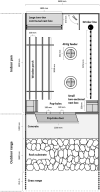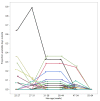Rearing Enrichments Affected Ranging Behavior in Free-Range Laying Hens
- PMID: 32923462
- PMCID: PMC7457029
- DOI: 10.3389/fvets.2020.00446
Rearing Enrichments Affected Ranging Behavior in Free-Range Laying Hens
Abstract
Within Australia, free-range systems are prevalent, but pullets destined for range access are reared indoors. This mismatch between rearing and layer housing may hinder adaptation to the free-range environment. Rearing enrichments could enhance pullet development. A total of 1,386 Hy-Line Brown® chicks were reared inside an experimental facility across 16 weeks with 3 enrichment treatments including (1) a control group with standard floor-housing, (2) a novelty group providing novel objects that changed weekly ("novelty" hens), and (3) a structural group with custom-designed H-shaped structures including opaque sides ("structural" hens). At 16 weeks of age, all pullets were leg-banded with microchips and moved to an experimental free-range system with 9 identical pens (n = 3/rearing treatment). From 25 to 64 weeks, individual hen daily ranging behavior was tracked via radio-frequency identification technology and grouped into 6 age periods per rearing treatment. Video footage was used to count the number of hens at different distances on the range for the first 14 days of access, and eggs were assessed for albumen corticosterone concentrations 4 days prior to (n = 450) and 1 week after first range access (n = 450). Across most age periods, the structural hens spent the most time ranging (P ≤ 0.01), the novelty hens showed the fewest number of visits to the range (P < 0.0001), and both enriched hen groups had the longest maximum visit durations (P ≤ 0.02). Range use increased with age across all treatments with only 3% of hens never going outside. All hens were initially slow to use the range area with fewer novelty hens venturing farther onto the range (P ≤ 0.03). The structural hens had higher albumen corticosterone concentrations and variance (both P ≤ 0.004) prior to range access. All hens showed an increase in albumen corticosterone following the first week of range access resulting in no differences between rearing treatments in means (P = 0.92) and variance (P = 0.63). Different enrichments have differing impacts on ranging behavior, but further research is needed to understand the mechanisms of effects, with differences in brain lateralization a potential hypothesis to be tested.
Keywords: RFID; adaptability; chicken; corticosterone; hen; individual; stress; welfare.
Copyright © 2020 Campbell, Dyall, Downing, Cohen-Barnhouse and Lee.
Figures








Similar articles
-
Relationships Between Rearing Enrichments, Range Use, and an Environmental Stressor for Free-Range Laying Hen Welfare.Front Vet Sci. 2020 Aug 14;7:480. doi: 10.3389/fvets.2020.00480. eCollection 2020. Front Vet Sci. 2020. PMID: 32923465 Free PMC article.
-
Effects of outdoor ranging on external and internal health parameters for hens from different rearing enrichments.PeerJ. 2020 Mar 6;8:e8720. doi: 10.7717/peerj.8720. eCollection 2020. PeerJ. 2020. PMID: 32185113 Free PMC article.
-
Cecal Microbiota of Free-Range Hens Varied With Different Rearing Enrichments and Ranging Patterns.Front Microbiol. 2022 Feb 11;12:797396. doi: 10.3389/fmicb.2021.797396. eCollection 2021. Front Microbiol. 2022. PMID: 35222302 Free PMC article.
-
A review of environmental enrichment for laying hens during rearing in relation to their behavioral and physiological development.Poult Sci. 2019 Jan 1;98(1):9-28. doi: 10.3382/ps/pey319. Poult Sci. 2019. PMID: 30107615 Free PMC article. Review.
-
Welfare issues and potential solutions for laying hens in free range and organic production systems: A review based on literature and interviews.Front Vet Sci. 2022 Aug 5;9:952922. doi: 10.3389/fvets.2022.952922. eCollection 2022. Front Vet Sci. 2022. PMID: 35990274 Free PMC article. Review.
Cited by
-
Relationships Between Rearing Enrichments, Range Use, and an Environmental Stressor for Free-Range Laying Hen Welfare.Front Vet Sci. 2020 Aug 14;7:480. doi: 10.3389/fvets.2020.00480. eCollection 2020. Front Vet Sci. 2020. PMID: 32923465 Free PMC article.
-
An Initial Study on the Use of Machine Learning and Radio Frequency Identification Data for Predicting Health Outcomes in Free-Range Laying Hens.Animals (Basel). 2023 Mar 30;13(7):1202. doi: 10.3390/ani13071202. Animals (Basel). 2023. PMID: 37048458 Free PMC article.
-
Impacts of Rearing Enrichments on Pullets' and Free-Range Hens' Positive Behaviors across the Flock Cycle.Animals (Basel). 2022 Jan 23;12(3):280. doi: 10.3390/ani12030280. Animals (Basel). 2022. PMID: 35158604 Free PMC article.
-
Rearing enrichment affects perching behaviour and bone strength in pullets and in free-range hens varying in range use patterns.Vet Anim Sci. 2025 May 8;29:100461. doi: 10.1016/j.vas.2025.100461. eCollection 2025 Sep. Vet Anim Sci. 2025. PMID: 40487026 Free PMC article.
-
Low levels of chicken body louse (Menacanthus stramineus) infestations affect chicken welfare in a cage-free housing system.Parasit Vectors. 2024 May 14;17(1):221. doi: 10.1186/s13071-024-06313-6. Parasit Vectors. 2024. PMID: 38745229 Free PMC article.
References
-
- Carey R, Parker C, Scrinis G. Capturing the meaning of ‘free range’: The contest between producers, supermarkets and consumers for the higher welfare egg label in Australia. J Rural Stud. (2017) 54:266–75. 10.1016/j.jrurstud.2017.06.014 - DOI
-
- Bray HJ, Ankeny RA. Happy chickens lay tastier eggs: motivations for buying free-range eggs in Australia. Anthrozoös. (2017) 30:213–26. 10.1080/08927936.2017.1310986 - DOI
LinkOut - more resources
Full Text Sources

